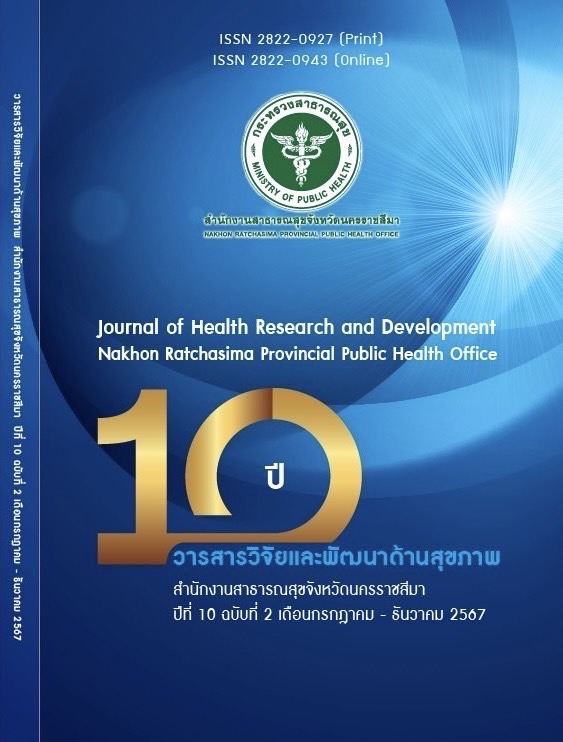ปัจจัยเสี่ยงที่มีผลต่อการเกิดภาวะระดับน้ำตาลในเลือดขณะอดอาหารผิดปกติและโรคเบาหวาน
คำสำคัญ:
ปัจจัยเสี่ยง, ภาวะระดับน้ำตาลในเลือดขณะอดอาหารผิดปกติ, ผู้ป่วยโรคเบาหวานชนิดที่ 2บทคัดย่อ
การวิจัยนี้เป็นการวิจัยเชิงพรรณนาภาคตัดขวาง (descriptive cross-sectional study) โดยมีวัตถุประสงค์เพื่อศึกษาปัจจัยที่มีผลต่อภาวะระดับน้ำตาลในเลือดขณะอดอาหารผิดปกติ (impaired fasting glucose) และโรคเบาหวานชนิดที่ 2 (Diabetes mellitus type 2) การเก็บข้อมูลจากผู้ป่วยคลินิกโรคไม่ติดต่อเรื้อรัง (NCD clinic) ที่โรงพยาบาลมหาวิทยาลัยเทคโนโลยีสุรนารี ตั้งแต่ 1 พฤศจิกายน 2566 ถึง 31 กรกฎาคม 2567 รวบรวมข้อมูลทั่วไป ปัจจัยเสี่ยง และผลการตรวจทางห้องปฏิบัติการ นำข้อมูลมาวิเคราะห์ด้วยสถิติ เชิงพรรณนา ได้แก่ ร้อยละ ค่าเฉลี่ย + ส่วนเบี่ยงเบนมาตรฐาน และ independent T-test
ผลการวิจัย พบว่า ผู้ป่วย จำนวน 115 คนพบว่าปัจจัยที่มีผลต่อระดับน้ำตาลในเลือดขณะอดอาหารผิดปกติและโรคเบาหวาน 3 ปัจจัย ได้แก่ อายุ ดัชนีมวลกายและรอบเอว และเมื่อทำการเปรียบเทียบผู้ป่วยที่มีภาวะระดับน้ำตาลในเลือดขณะอดอาหารผิดปกติและโรคเบาหวานกับผู้ป่วยที่มีภาวะระดับน้ำตาลในเลือดปกติ พบว่า ผู้ป่วยที่มีภาวะระดับน้ำตาลในเลือดขณะอดอาหารผิดปกติและโรคเบาหวาน มีอายุ 63.00+10.74 ปี และผู้ป่วยที่มีภาวะระดับน้ำตาลในเลือดปกติ อายุ 57.67+11.66 ปี (p = 0.034) ดัชนีมวลกายในผู้ป่วยที่มีภาวะระดับน้ำตาลในเลือดขณะอดอาหารผิดปกติและโรคเบาหวาน 27.44+4.72 กิโลกรัม/เมตร2 มากกว่าผู้ป่วยที่มีภาวะระดับน้ำตาลในเลือดปกติ 25.02+3.73 กิโลกรัม/เมตร2 (p = 0.006) รอบเอวในผู้ป่วยที่มีภาวะระดับน้ำตาลในเลือดขณะอดอาหารผิดปกติและโรคเบาหวาน 39.56+4.47 นิ้ว มากกว่าผู้ป่วยที่มีภาวะระดับน้ำตาลในเลือดปกติ 35.01+3.93 นิ้ว ซึ่งทั้งอายุ ดัชนีมวลกาย และรอบเอวมีความแตกต่างกันอย่างมีนัยสำคัญทางสถิติเมื่อเปรียบเทียบกันระหว่างผู้ป่วยที่มีภาวะระดับน้ำตาลในเลือดขณะอดอาหารผิดปกติและโรคเบาหวานกับผู้ป่วยที่มีภาวะน้ำตาลในเลือดปกติ (p < 0.050) สรุปว่า อายุ ดัชนีมวลกาย และรอบเอวที่ต่างกัน ซึ่งเป็นปัจจัยที่สามารถปรับเปลี่ยนได้ ก่อให้เกิด การเกิดภาวะระดับน้ำตาลในเลือดขณะอดอาหารผิดปกติและโรคเบาหวานต่างกัน
References
Van der Schaft N, Brahimaj A, Wen KX, et al. The association between serum uric acid and the incidence of prediabetes and type 2 diabetes mellitus: The Rotterdam Study. PLoS One 2017;12(6) : e0179482.
Lv Q, Meng XF, He FF, et al. High serum uric acid and increased risk of type 2 diabetes: A systemic review and meta-analysis of prospective cohort studies. PLoS ONE 2013; 8(2): e56864.
El Ridi R, Tallima H. Physiological functions and pathogenic potential of uric acid: A review. J of Advanced Res 2017; 8(5): 487 – 93.
Jia L, Xing J, Ding Y, et al. Hyperuricemia causes pancreatic [5]β-cell death and dysfunction through NF-κB signaling pathway. PLoS One 2013; 8(10): e78284.
Sluijs I, Holmes MV, van der Schouw YT, et al. A Mendelian randomization study of circulating uric acid and type 2 diabetes. Diabetes 2015;64(8):3028 – 36.
Volpe A, Ye C, Hanley AJ, et al. Changes over time in uric acid in relation to changes in insulin sensitivity, beta-cell function, and glycemia. J Clin Endocrinol Metab 2020; 105(3): e651 – 59.
Pittas AG, Lau J, Hu FB, et al. The role of vitamin D and calcium in type 2 diabetes. A systematic review and meta-analysis. J Clin Endocrinol Metab 2007;92(6): 2017-29.
Pilla SJ, Balasubramanyam A, Knowler WC, et al. Islet autoantibody positivity in overweight and obese adults with type 2 diabetes. Autoimmunity 2018; 51: 408-16.
Bellou V, Belbasis L, Tzoulaki I, et al. Risk factors for type 2 diabetes mellitus: an exposure-wide umbrella review of meta-analyses. PLoS One 2018; 13: e0194127.
Haque T, Rahman S, Islam S, et al. Assessment of the relationship between serum uric acid and glucose levels in healthy, prediabetic and diabetic individuals. Diabetol Metab Syndr 2019;11 : 49.
Causevic A, Semiz S, Macic Dzankovic A, et al. Relevance of uric acid in progression of type 2 diabetes mellitus. Bosn J Basic Med Sci 2010; 10(1): 54 – 9.
Grover A, Mowar AB, Johri S. Prevalence of hyperuricemia in newly diagnosed type 2 diabetes mellitus patients. Int J Adv Med 2019; 6 :276 – 8.
Lee SB, Ahn CW, Lee BK, et al. Association between triglyceride glucose index and arterial stiffness in Korean adults. Cardiovasc Diabetol 2018;17 : 1 – 6.
Robertson RP, Harmon J, Tran POT, et al. β‐Cell glucose toxicity, lipotoxicity, and chronic oxidative stress in type 2 diabetes. Diabetes 2004; 53: S119 – 24.
Kahn AM, Allen JC, Seidel CL, et al. Insulin inhibits migration of vascular smooth muscle cells with inducible nitric oxide synthase. Hypertension 2000; 35 : 303 – 6.
Defronzo RA. From the triumvirate to the “ominous octet”: a new paradigm for the treatment of type 2 diabetes mellitus. Clin Diabetol 2009; 10: 101 – 28.
Kim MK, Ahn CW, Kang S, et al. Relationship between the triglyceride glucose index and coronary artery calcification in Korean adults. Cardiovasc Diabetol 2017; 16 : 1 – 7.
Zheng T, Ge B, Liu H, et al. Triglyceride‐mediated influence of serum angiopoietin‐like protein 8 on subclinical atherosclerosis in type 2 diabetic patients: results from the GDMD study in China. Cardiovasc Diabetol 2018;17:1-8.
Lindstrom J, Ilanne-Parikka P, Peltonen M, et al. Sustained reduction in the incidence of type 2 diabetes by lifestyle intervention: follow-up of the Finnish diabetes prevention study. Lancet 2006; 368: 1673 – 9.
Knowler WC, Fowler SE, Hamman RF, et al. 10-year follow-up of diabetes incidence and weight loss in the diabetes prevention program outcomes study. Lancet 2009; 374: 1677 – 86.
Tabák AG, Herder C, Rathmann W, Brunner EJ, Kivimäki M. Prediabetes: a high-risk state for diabetes development. The Lancet 2012; 379(9833): 2279 – 90.
Larsson H, Lindgärde F, Berglund G, Ahren B. Prediction of diabetes using ADA or WHO criteria in post-menopausal women: a 10-year follow-up study. Diabetologia 2000;43(10): 1224 – 8.
Downloads
เผยแพร่แล้ว
How to Cite
ฉบับ
บท
License
Copyright (c) 2025 สำนักงานสาธารณสุขจังหวัดนครราชสีมา

This work is licensed under a Creative Commons Attribution-NonCommercial-NoDerivatives 4.0 International License.
บทความที่ได้รับการตีพิมพ์เป็นลิขสิทธิ์ของสำนักงานสาธารณสุขจังหวัดนครราชสีมา กระทรวงสาธารณสุข
ข้อความที่ปรากฏในบทความแต่ละเรื่องในวารสารวิชาการเล่มนี้เป็นความคิดเห็นส่วนตัวของผู้เขียนแต่ละท่านไม่เกี่ยวข้องกับสำนักงานสาธารณสุขจังหวัดนครราชสีมา และบุคลากรท่านอื่นๆในสำนักงานฯ แต่อย่างใด ความรับผิดชอบองค์ประกอบทั้งหมดของบทความแต่ละเรื่องเป็นของผู้เขียนแต่ละท่าน หากมีความผิดพลาดใดๆ ผู้เขียนแต่ละท่านจะรับผิดชอบบทความของตนเองแต่ผู้เดียว


